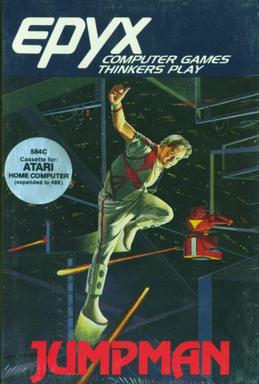
Jumpman is a platform game written by Randy Glover and published by Epyx in 1983. It was developed for the Atari 8-bit computers, and versions were also released for the Commodore 64, Apple II, and IBM PC compatibles.
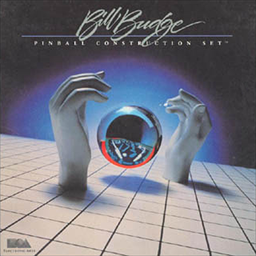
Pinball Construction Set is a video game by Bill Budge written for the Apple II. It was originally published in 1982 through Budge's own company, BudgeCo, then was released by Electronic Arts in 1983 along with ports to the Atari 8-bit computers and Commodore 64.

Lode Runner is a 2D puzzle-platform game, developed by Doug Smith and published by Broderbund in 1983. Its gameplay mechanics are similar to Space Panic from 1980. The player controls a character who must collect all the gold pieces in a level and get to the end while being chased by a number of enemies. It is one of the first games to include a level editor.

Choplifter is a military themed scrolling shooter developed by Dan Gorlin for the Apple II and published by Broderbund in 1982. It was ported to Atari 8-bit computers the same year and also to the VIC-20, Commodore 64, Atari 5200, ColecoVision, MSX, and Thomson computers.

Bill Budge is a retired American video game programmer and designer. He is best known for the Apple II games Raster Blaster (1981) and Pinball Construction Set (1983).

Shamus is a shooter with light action-adventure game elements written by Cathryn Mataga and published by Synapse Software. The original Atari 8-bit computer version was released on disk and tape in 1982. According to Synapse co-founder Ihor Wolosenko, Shamus made the company famous by giving it a reputation for quality. "Funeral March of a Marionette", the theme song from Alfred Hitchcock Presents, plays on the title screen.

Softalk was an American magazine of the early 1980s that focused on the Apple II computer. Published from September 1980 through August 1984, it featured articles about hardware and software associated with the Apple II platform and the people and companies who made them. The name was originally used on a newsletter of Apple Software pioneer company, Softape, who in 1980 changed its name to Artsci Inc.
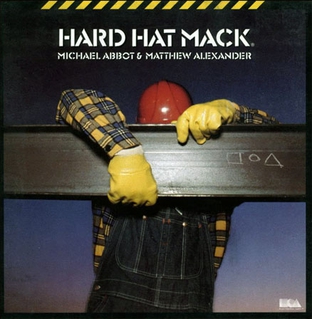
Hard Hat Mack is a platform game developed by Michael Abbot and Matthew Alexander for the Apple II which was published by Electronic Arts in 1983. Ports for the Atari 8-bit computers and Commodore 64 were released simultaneously. It is part of the first batch of five games from Electronic Arts, and the company called it out as "truly EA's first game." Versions for the Amstrad CPC and IBM PC compatibles followed in 1984.
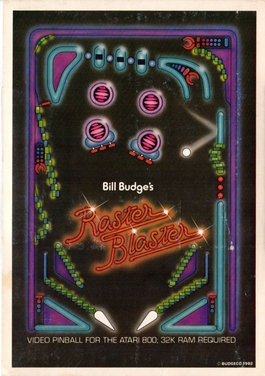
Bill Budge's Raster Blaster is a home computer pinball simulation written by Bill Budge for the Apple II and published in 1981 by Budge's company, BudgeCo. It was ported to the Atari 8-bit computers. Raster Blaster resembles the Williams Firepower table from 1980.

Drol is a video game published by Broderbund in 1983. It was written for the Apple II by Benny Aik Beng Ngo, then ported to the Commodore 64 and Atari 8-bit computers. Versions were released for the SG-1000 in 1985 and Amiga in 1991.
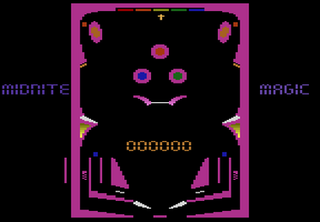
Midnight Magic is a pinball video game written by Glenn Axworthy for the Atari 2600 and released by Atari Corporation in 1986, although on-screen it displays a copyright of 1984.

The Mask of the Sun is a graphical interactive fiction game for the Apple II developed by Ultrasoft and published in 1982 in North America by Broderbund and in Europe by Ariolasoft. Versions for the Atari 8-bit computers and Commodore 64 were released in 1984.

Fort Apocalypse is a multidirectional scrolling shooter for Atari 8-bit computers created by Steve Hales and published by Synapse Software in 1982. Joe Vierra ported it to the Commodore 64 the same year. The player navigates an underground prison in a helicopter, destroying or avoiding enemies and rescuing prisoners. A contemporary of Choplifter, it has similarities to that game as well as the arcade games Scramble and Super Cobra.
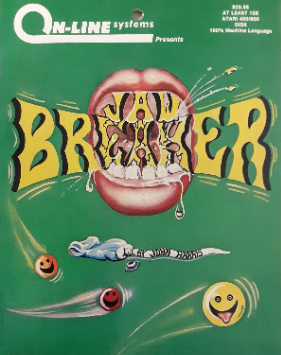
Jawbreaker is a Pac-Man clone programmed by John Harris for Atari 8-bit computers and published by On-Line Systems. Released in 1981 before an official version of Pac-Man was available, it was widely lauded by reviewers and became a major seller. The story of its creation and Harris's Atari 8-bit implementation of Frogger form a portion of Steven Levy's 1984 book, Hackers: Heroes of the Computer Revolution.

Serpentine is a maze video game written by David Snider for the Apple II and published by Broderbund in 1982. Serpentine's gameplay and visuals are similar to the Konami arcade game, Jungler, released the previous year. It was ported to the Commodore 64 and Atari 8-bit computers. A VIC-20 version was licensed to Creative Software.
Dazzle Draw is a raster graphics editor for the Apple IIc and Apple IIe. The program allows users to create bitmap images which can then be printed or used in other programs. Developed by David Snider and released in 1984 by Broderbund, the program is similar to MacPaint, released in early 1984. Snider previously wrote the Apple II pinball game David's Midnight Magic.
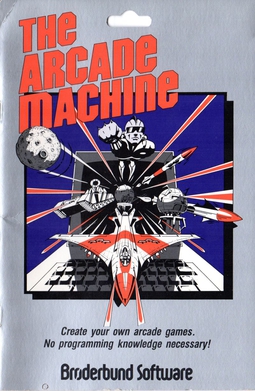
The Arcade Machine is a game creation system written by Chris Jochumson and Doug Carlston for the Apple II and published by Broderbund in 1982. Louis Ewens ported it to Atari 8-bit computers. Broderbund ran a contest from January–June 1984 where the best user-created game was awarded a prize of $1,500 in hardware and software. Jochumson also wrote Track Attack for Broderbund.

Gumball is a video game written for the Apple II by Veda Hlubinka-Cook and published by Broderbund in 1983. It was ported to the Atari 8-bit computers, and Commodore 64. The player controls the valves of a maze-like machine to sort gumballs by color.

Night Mission Pinball is a pinball simulation video game published by Sublogic in 1982. It was developed by Bruce Artwick for the Apple II, then ported to the Atari 8-bit family, Commodore 64, and IBM PC.

A.E. is a fixed shooter written by Jun Wada and Makoto Horai for the Apple II and Atari 8-bit computers and published by Broderbund in 1982. Versions followed for the VIC-20 (1983) and MSX (1984). Unlike most earlier shooters which have a solid color or starfield as a background, the action in A.E. takes place in front of science fiction scenes. Attacking creatures emerge from points in the image, often appearing to come from behind objects. Combined with a slight scaling as they advance, there is the impression of depth.




















